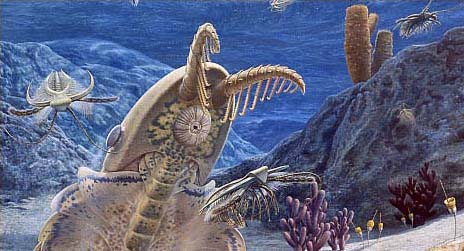 |
 |
 |
 |
 |
Produced
by the Population Genetics and Evolution class, Furman University |
||||
 |
 |
 |
 |
 |
Produced
by the Population Genetics and Evolution class, Furman University |
||||
 |
The
Cambrian: Archaeocyathans |
 |
||
| The lower Cambrian
period marked the appearance of Archaeocyathans, a type of prolific marine
organism. Some species were responsible for the first reef ecosystems,
an important type of ecological community even today. This group radiated
into many different species during this period, but they became extinct
after a brief 10 or 15 million years (Collins and Waggoner 2006). Archaeocyanthans
are thought to be relatives of our modern sponges. They possessed a calcium-based
backbone and two stacked cones connected by septa, suggestive of a filter
feeding mechanism like that of modern sponges. The image on the right
demonstrates a cross-section of the inner and outer cones connected by
a matrix of septa. As seafloor dwellers, they sometimes formed communities
but were often found alone. They seem to have preferred a shallow, open
seabed of carbonate with high oxygen availability (Kazlev 2002). An interesting
feature of Archaeocyathans is their evolutionary trend towards increasingly
complex branching of its cup morphology. Its simple shape early in the
Cambrian progressed to branched shapes present in the majority of genera
at the end of its history, suggesting an evolutionary advantage to this
morphology (Wood 2001).
Page by Tory Grimm-Oropesa |
 |
| Archaeocyath with coin for scale. Photo credit: UCMP | |
|
Collins AG, Waggoner B. 2006. Archaeocyatha. University of California Museum of Paleontology. Accessed February 2010. Kazlev MA. 2002. Metazoa: Porifera: Archaeocyatha. www.palaeos.com. Accessed February 2010. Wood, R. 2001. AccessScience: Encyclopedia Article: Archaeocyatha. McGraw-Hill’s Access Science Encyclopedia of Science and Technology Online.Accessed February 2010. |